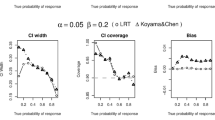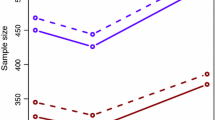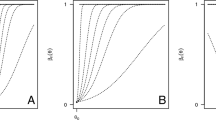Abstract
In a one-sided hypothesis testing problem in clinical trials, the monotonic condition of a tail probability function is fundamentally important to guarantee that the actual type I and II error rates occur at the boundary of their associated parameter spaces. Otherwise, one has to search for the actual rates over the complete parameter space, which could be very computationally intensive. This important property has been extensively studied in traditional one-stage study settings (e.g., non-inferiority or superiority between two binomial proportions), but there is very limited research for this property in a two-stage design setting, e.g., Simon’s two-stage design. In this note, we theoretically prove that the tail probability is an increasing function of the parameter in Simon’s two-stage design. This proof not only provides theoretical justification that p-value occurs at the boundary of the parameter space, but also helps to reduce the computational intensity for study design search.
Similar content being viewed by others
References
Clopper CJ, Pearson ES (1934) The use of confidence or fiducial limits illustrated in the case of the binomial. Biometrika 26(4):404–413. doi:10.1093/biomet/26.4.404
Jung S-HH, Kim KMM (2004) On the estimation of the binomial probability in multistage clinical trials. Stat Med 23(6):881–896. doi:10.1002/sim.1653
Kang L, Tian L (2013) Estimation of the volume under the ROC surface with three ordinal diagnostic categories. Comput Stat Data Anal 62:39–51. doi:10.1016/j.csda.2013.01.004
Kang L, Xiong C, Crane P, Tian L (2013) Linear combinations of biomarkers to improve diagnostic accuracy with three ordinal diagnostic categories. Stat Med 32(4):631–643. doi:10.1002/sim.5542
Katz PO, Gerson LB, Vela MF (2013) Guidelines for the diagnosis and management of gastroesophageal reflux disease. Am J gastroenterol 108(3):308–328
Röhmel J (2005) Problems with existing procedures to calculate exact unconditional P-values for non-inferiority/superiority and confidence intervals for two binomials and how to resolve them. Biom J 47(1):37–47
Röhmel J, Mansmann U (1999) Unconditional non-asymptotic one-sided tests for independent binomial proportions when the interest lies in showing non-inferiority and/or superiority. Biom J 41(2):149–170
Shan G, Chen JJ, Ma C (2016) Boundary problem in Simon’s two-stage clinical trial designs. J Biopharm stat. doi:10.1080/10543406.2016.1148716
Shan G, Ma C (2016) Unconditional tests for comparing two ordered multinomials. Stat Methods Med Res 25(1):241–254. doi:10.1177/0962280212450957
Shan G, Wilding GE, Hutson AD, Gerstenberger S (2016) Optimal adaptive two-stage designs for early phase II clinical trials. Stat Med 35(8):1257–1266. doi:10.1002/sim.6794
Siefker-Radtke AO, Dinney CP, Shen Y, Williams DL, Kamat AM, Grossman HB, Millikan RE (2013) A phase 2 clinical trial of sequential neoadjuvant chemotherapy with ifosfamide, doxorubicin, and gemcitabine followed by cisplatin, gemcitabine, and ifosfamide in locally advanced urothelial cancer. Cancer 119(3):540–547. doi:10.1002/cncr.27751
Simon R (1989) Optimal two-stage designs for phase II clinical trials. Control Clin trials 10(1):1–10
Tsai W-YY, Chi Y, Chen C-MM (2008) Interval estimation of binomial proportion in clinical trials with a two-stage design. Stat Med 27(1):15–35
Tsou H-H, Hsiao CF, Chow S-C, Liu J-P (2008) A two-stage design for drug screening trials based on continuous endpoints. Drug Inf J 42(3):253–262. doi:10.1177/009286150804200307
Zheng L, Rosenkranz SL, Taiwo B, Para MF, Eron JJ, Hughes MD (2012) The design of single-arm clinical trials of combination antiretroviral regimens for treatment-naive HIV-infected patients. AIDS Res Hum Retrovir 29(4):652–657. doi:10.1089/aid.2012.0180
Acknowledgments
The authors are very grateful to the Associate Editor and a referee for their insightful comments that help improve the manuscript. Shan’s research is partially supported by grants from the National Institute of General Medical Sciences from the National Institutes of Health: P20GM109025, P20GM103440, and 5U54GM104944. Zhang’s work was supported by the Zhejiang Provincial Natural Science Foundation of China (Grant No. LY15F020001) and the National Natural Science Foundation of China (Grant No. 61170099). We also thank Dr. Huichi Huang from Chongqing University for the discussion of this research.
Author information
Authors and Affiliations
Corresponding author
Rights and permissions
About this article
Cite this article
Shan, G., Zhang, H., Jiang, T. et al. Exact p-Values for Simon’s Two-Stage Designs in Clinical Trials. Stat Biosci 8, 351–357 (2016). https://doi.org/10.1007/s12561-016-9152-1
Received:
Revised:
Accepted:
Published:
Issue Date:
DOI: https://doi.org/10.1007/s12561-016-9152-1




